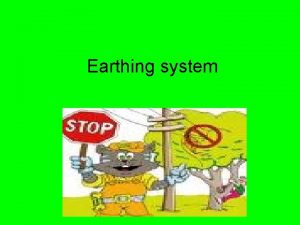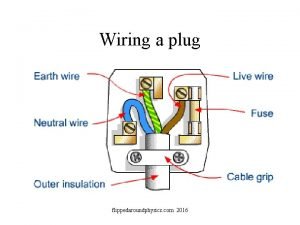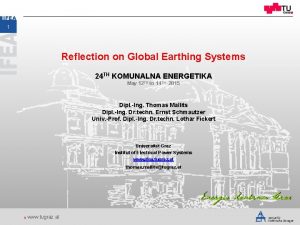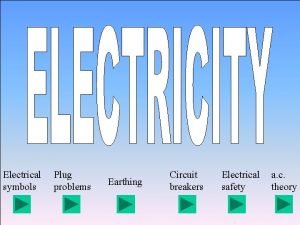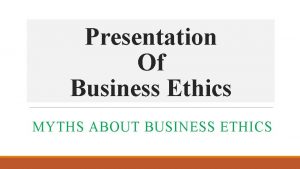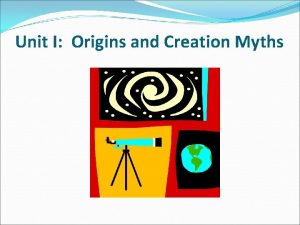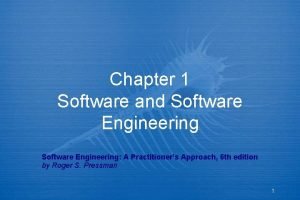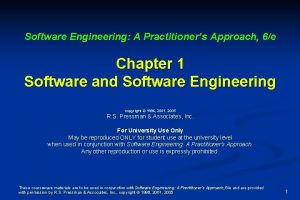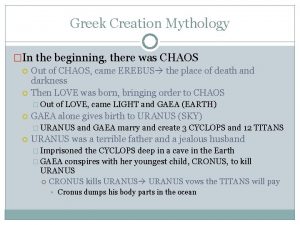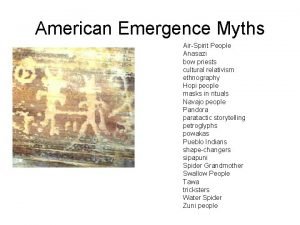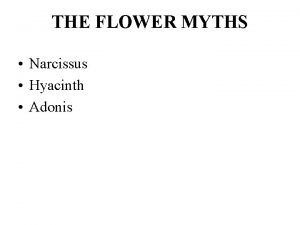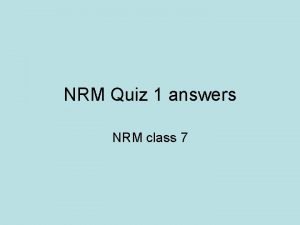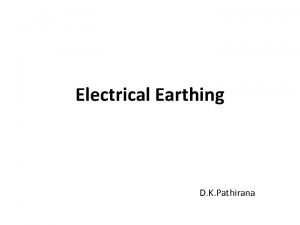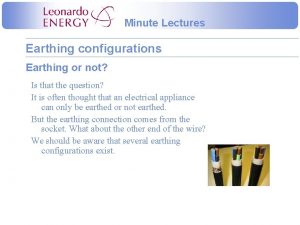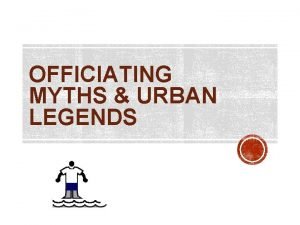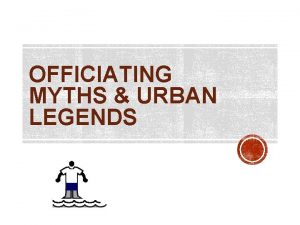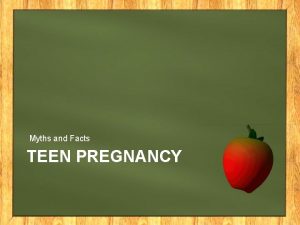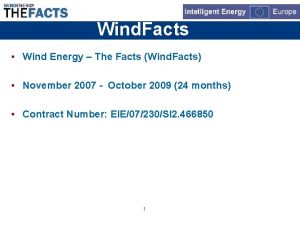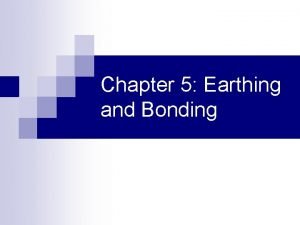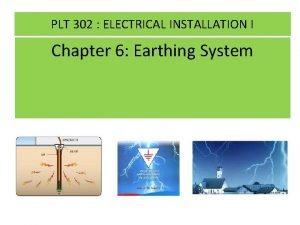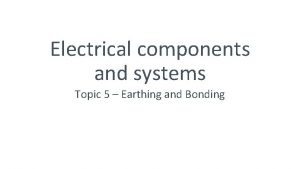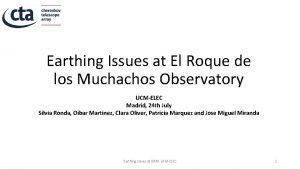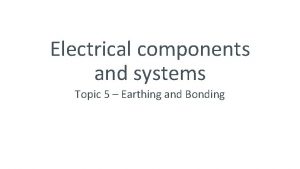Earthing Myths Facts A S Walkey Earthing Myths









































- Slides: 41

Earthing – Myths & Facts A. S. Walkey

Earthing – Myths & Facts • Problems in industrial/commercial premises, wiring & grounding system account for a large share of all reported power quality problems. • Most of the wiring and grounding problems is in the feeders and branch circuits serving critical loads. • The first activity in checking for PQ problems is to survey the soundness of the power distribution system and grounding system, supplying the equipment.

Earthing – Myths & Facts • Through error or oversight, intentional or unintentional, the grounding system in many cases is not installed in accordance with the requirements of the National/International Standards or Local Electrical Codes of Practice. (vide Clause 6. 4. 1 of IEEE 1100). • Even if installed properly, proper maintenance of the earthing system is questionable, mostly guided by incorrect practices.

Earthing – Myths & Facts The most popular word among electrical professionals would, perhaps, be ‘Earthing’ or ‘Grounding’. Many of you must have come across certain strange practices and beliefs in earthing of electrical power systems. This presentation aims to discuss some of such practices & beliefs and to clarify the misbeliefs.

Earthing – Myths & Facts Myth: ‘Grounding’ implies connection of current carrying parts to ground, like transformer or generator neutral and ‘Earthing’ implies connection of non-current carrying parts to ground, like metallic enclosures.

Earthing – Myths & Facts Fact: • As per IS 3043 -1987, vide Cl. 0. 7, the terms ‘Earthing’ and ‘Grounding’ are synonymous. • Perhaps the different nomenclature is due to the usual conflicting usage of English language between the Americans & the British. While the British termed it as ‘Earthing’ and Americans termed it as ‘Grounding’. • IEC & IS Standards refer as ‘Earthing’, while IEEE & ANSI Standards refer as ‘Grounding’.

Earthing – Myths & Facts To quote from IEC 60050: “The terms ‘earth’ as well as ‘ground’ have both been in general use to describe the common power/signal reference point interchangeably around the world in the Electro-technical terminology. While the USA and other North American countries favor the use of the term ‘ground’, European countries including the UK and many other Eastern countries prefer the term ‘earth’”.

Earthing – Myths & Facts To quote from “Earthing Practice” –(vide BS 7430: 1991 Code of Practice for. Earthing): “It is worth noting that in Europe we tend to use the term earthing, whilst in north America, the term “grounding” is more common. The IEEE definition of grounding is: “Ground (ground system) - A conducting connection, whether intentional or accidental, by which an electric circuit or equipment is connected to the earth or some conducting body of relatively large extent that serves in place of the earth. ”

Earthing – Myths & Facts

Earthing – Myths & Facts

Earthing – Myths & Facts

Earthing – Myths & Facts Myth: Natural earth serves as a return path for fault current.

Earthing – Myths & Facts Fact: Though this may be true in some cases, one would be surprised to note that natural earth is a very poor conductor of electric current. Yes! The typical resistivity of the general mass of earth is about 100 Ohm-m. Compare this with the resistivity of Copper, which is, 1. 7 x 10 -8 Ohm-m and that of GI, which is, 1 x 10 -7 Ohm-m.

Earthing – Myths & Facts • Definitely, natural earth is much more resistive than Copper or GI. Even the Indian Standard (IS 3043 -1987) recognizes this fact. It mentions in its clause 0. 3 that ‘the earth now rarely serves as a part of the return circuit, but is being used mainly for fixing the voltage of the system neutrals’.

Earthing – Myths & Facts • That is why the recent practice is to use a metallic conductor, as the return path for the fault current. This conductor is termed as the earth conductor. The earth conductor are earthed at one or many places along its length, only to bring its potential close to the earth potential, which, conventionally is taken as zero (vide Cl. 2. 7 of IS 3043).

Earthing – Myths & Facts • Myth: Copper Earth Electrodes are better than GI or Steel Earth Electrodes

Earthing – Myths & Facts Fact: • If one considers a plate electrode, the approximate resistance to earth is: l R = ρ----- Ohms (IS 3043) A where, ρ = Resistivity of the soil in Ohm-m A = Area of both sides of the plate in m 2

Earthing – Myths & Facts • Similarly, for Rod or Pipe Electrodes, 100 ρ 4 l R = ------- loge ---- Ohms 2πl d where, ρ = Resistivity of the soil in Ohm-m l = Length of the Rod or Pipe in cm d = Diameter of the Rod or Pipe in cm.

Earthing – Myths & Facts • And, for Strip or Conductor Electrodes, 100 ρ 2 l 2 R = ------- loge ----- Ohms 2πl wt where, ρ = Resistivity of the soil in Ohm-m L = Length of the Strip in cm w = Depth of burial of the electrode in cm t = Width (in the case of Strip) or Twice the diameter (in the case of Conductor) in cm.

Earthing – Myths & Facts • As can be seen from the formulae mentioned in previous slides, only the resistivity of the soil and the physical dimensions of the electrode play a major role in determining the electrode resistance to earth. • The material resistivity is not considered anywhere in the formulae.

Earthing – Myths & Facts • Myth: Plate Earthing is better than Pipe Earthing

Earthing – Myths & Facts Fact: • It is common to find that plate(Copper) earthing is preferred – rather insisted upon, by some designers – (at least for system earthing i. e. to earth the neutrals of Transformers & Generators) over Pipe or Rod or Strip Earthing. • This is because of the belief based on Ohm’s Law that more surface area means less resistance.

Earthing – Myths & Facts • To examine this, let us consider a Copper plate electrode of size 1. 2 m x 3. 15 mm thick. Assuming a soil resistivity of 100 Ohm-m, the resistance of this electrode to earth will be: ρ π 100 3. 14 R = ----- √ ---- Ohms = ------ x √ ------A A 2. 88 = 36. 27 Ohms

Earthing – Myths & Facts Now, consider a GI Pipe Electrode of 50 mm Diameter and 3 m Long. Assuming a soil resistivity of 100 Ohmm, the resistance of this electrode to earth will be: 100 ρ 4 l R = ------- loge ---- Ohms 2πl d 100 x 100 4 x 300 = --------- x loge -----2 x 3. 14 x 300 5 = 29. 09 Ω.

Earthing – Myths & Facts • As can be seen from the above calculation the GI Pipe electrode offers a much lesser resistance than even a copper plate electrode. • IS 3043 too acknowledges this fact vide Cl. 9. 1. 1, wherein it states that ‘a pipe, rod or strip has a much lower resistance than a plate of equal surface area’.

Earthing – Myths & Facts Myth: More water, less resistance; It is observed that in some installations, to bring down the earth resistance value, buckets and buckets of water is poured into the earth pit (that too, days just before the Electrical Inspector is due to arrive for inspecting the installation)

Earthing – Myths & Facts Fact: The resistance to earth of a given earth electrode depends upon the electrical resistivity of the soil in which it is installed. Moisture content is one of the controlling factors of earth resistivity.


Earthing – Myths & Facts • As can be seen from the above graph, above about 20 percent moisture content, the resistivity is very little affected. Below 20 percent, the resistivity increases abruptly with the decrease in moisture content. • A difference of a few percent moisture content will, therefore, have a marked difference in the soil resistivity, if moisture content falls below 20 percent.

Earthing – Myths & Facts • If the moisture content is already above 20 percent, there is no point in adding barrels of water into the earth pit, except perhaps wasting an important and scarce national resource like water. • The normal moisture content of soil is 10 percent in dry seasons to 35 percent in wet seasons, averaging between 16 and 18 percent.

Earthing – Myths & Facts Myth: More salt, less resistance; it was also observed in some installations that the earth pit is filled to the top with salt and charcoal (this too, just days before the Electrical Inspector is due to arrive for inspecting the installation).

Earthing – Myths & Facts Fact: To reduce soil resistivity, it is necessary to dissolve in the moisture, normally contained in the soil, some substance, which is highly conductive in its water solution. The most commonly used substances are salt & charcoal in suitable proportion.

Earthing – Myths & Facts It must be noted that the additive substance would reduce the resistivity of the soil, only when it is dissolved in the moisture in the soil. Dry additives do not serve any purpose at all. So, there is no point again, in just filling up the pit with salt & charcoal.


Earthing – Myths & Facts • As it can be seen from the above, the curve flattens off at about 5 percent. A further increase in salt content will give a very little decrease in soil resistivity. The salt content is expressed in percent by weight of the moisture content in the soil. Considering 1 M 3 of Soil, the moisture content at 10 percent will be about 144 kg. (10 percent of 1440 kg). The salt content shall be 5% of this (i. e. ) 5% of 144 kg, that is, about 7. 2 kg.

Earthing – Myths & Facts • So, water addition should be about 144 kg and salt addition shall be about 7. 2 kg per cubic metre of dry soil. Any further additions will not give appreciable benefits.

Earthing – Myths & Facts Myth: Deeper the earth pit and longer the earth pipe/rod, lesser will be the resistance

Earthing – Myths & Facts Fact: The resistance to earth of a pipe or rod electrode diminishes rapidly within the first few feet of driving, but less so at depths greater than 2 to 3 m in soil of uniform resistivity. After about 4 m depth, there is no appreciable change in resistance to earth of the electrode. Except in special cases, a number of rods in parallel are to be preferred to a single long rod.

Earthing – Myths & Facts • When a number of rods or pipes are connected in parallel, the resistance is practically proportional to the reciprocal of the number employed.

Earthing – Myths & Facts References: • IS 3043 -1987: Indian Standard Code of Practice for Earthing • IEEE Std. 142 -1991: IEEE Recommended Practice for Grounding of Industrial and Commercial Power Systems • Earthing Practice – CDA Publication 119 -1997

Earthing – Myths & Facts
 Hurricane myths and legends
Hurricane myths and legends The objectives of earthing is
The objectives of earthing is Earthing transformer protection
Earthing transformer protection Pe protective earth
Pe protective earth Ground live neutral
Ground live neutral Bs en 50522 2010
Bs en 50522 2010 Earthing symbol electrical
Earthing symbol electrical Hgc3
Hgc3 64:8+9:9-63:7
64:8+9:9-63:7 Legends and myths difference
Legends and myths difference Myths about termites
Myths about termites If a software production gets behind schedule
If a software production gets behind schedule Myths of business ethics
Myths of business ethics Origin myths definition
Origin myths definition Generic viagra myths
Generic viagra myths Myths and legends of king arthur
Myths and legends of king arthur Practitioner myths in software engineering
Practitioner myths in software engineering Myths and fallacies about non communicable diseases
Myths and fallacies about non communicable diseases Polish legends: the dragon
Polish legends: the dragon Equation for drag
Equation for drag Chapter 10:1 myths on aging
Chapter 10:1 myths on aging Myths legends fables and fairy tales
Myths legends fables and fairy tales Myths and legends robin hood
Myths and legends robin hood Practitioner myths in software engineering
Practitioner myths in software engineering Irish myths and legends lesson plans
Irish myths and legends lesson plans Tengrism gods
Tengrism gods Myths of business ethics
Myths of business ethics What is a myth
What is a myth Comets diagram
Comets diagram Why do people tell myths
Why do people tell myths Greek myths essay
Greek myths essay Myths about pirates
Myths about pirates Chaos in greek mythology
Chaos in greek mythology Alexm
Alexm Myth vs fable
Myth vs fable The legend of king midas
The legend of king midas What are myths legends and folktales
What are myths legends and folktales Adonis narcissus.com
Adonis narcissus.com Bulgarian mythical creatures
Bulgarian mythical creatures Types of myths
Types of myths 5 myths about attic ventilation
5 myths about attic ventilation Myths and legends quiz questions and answers
Myths and legends quiz questions and answers



